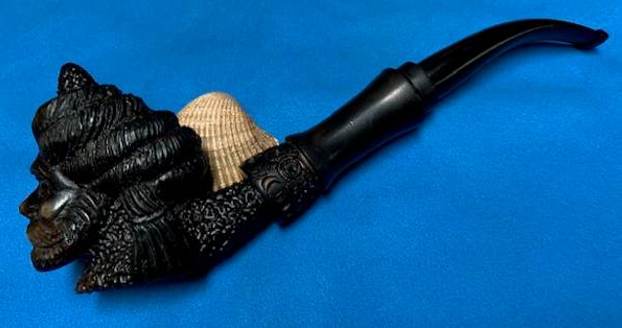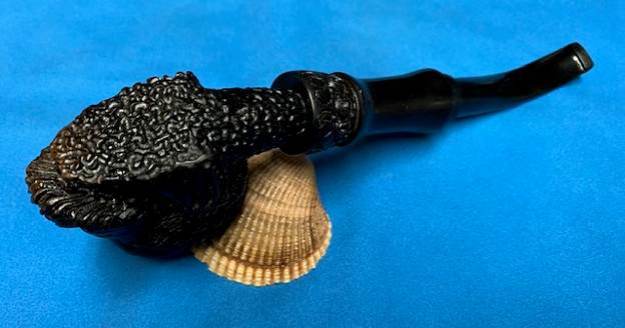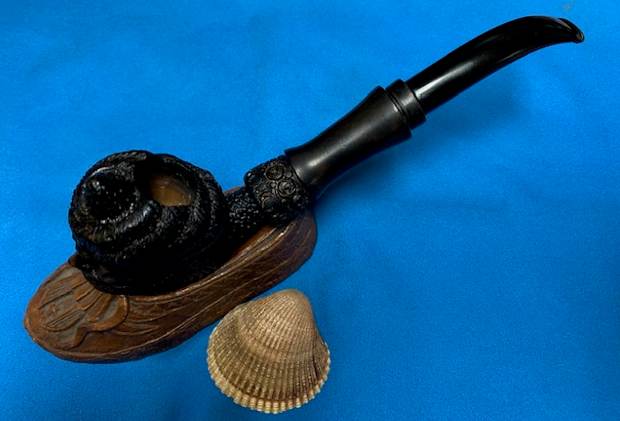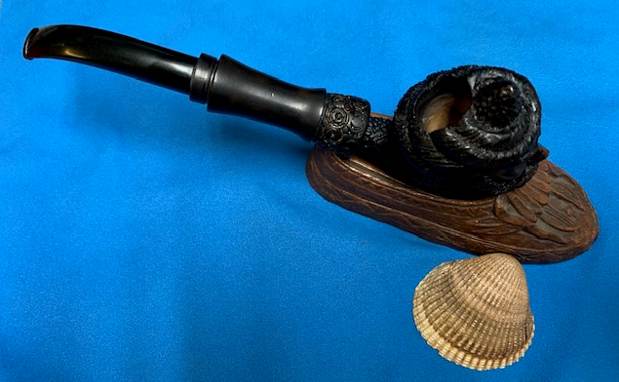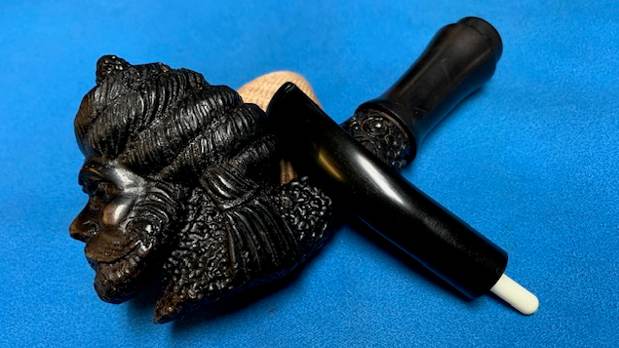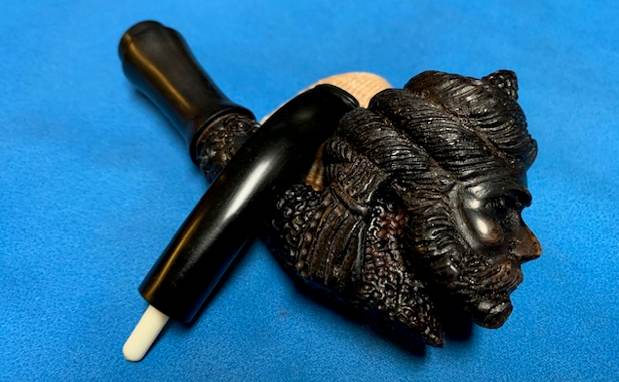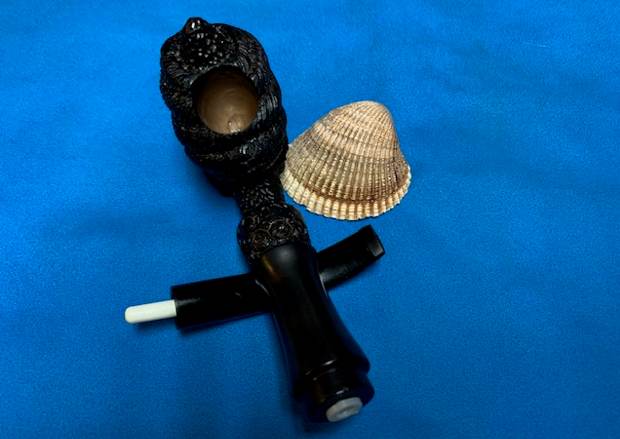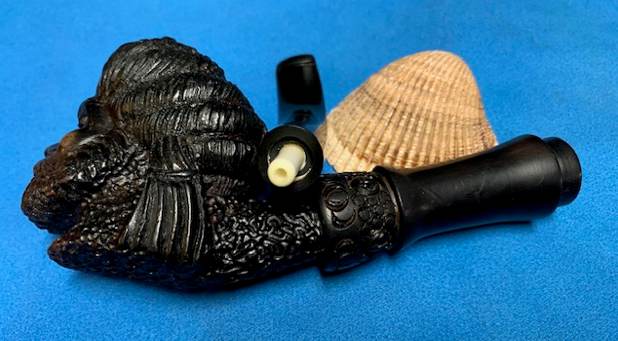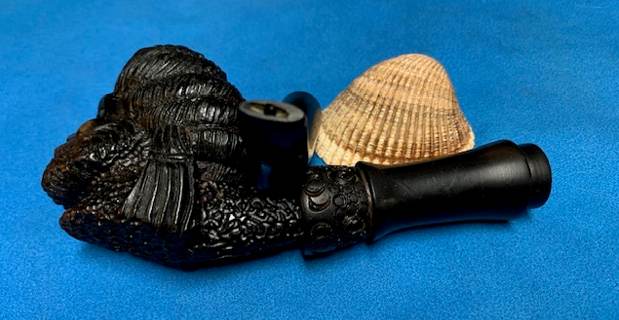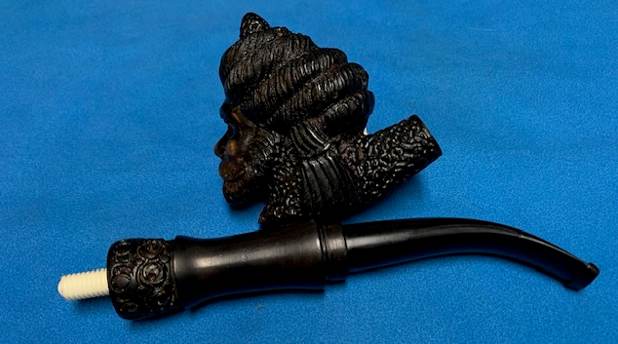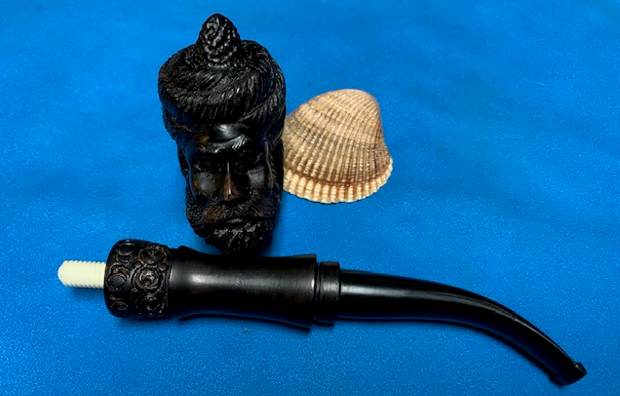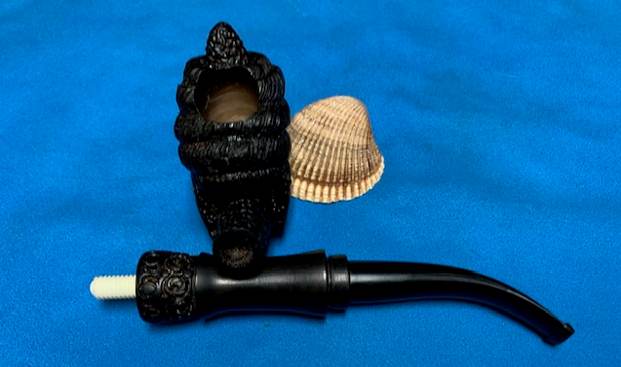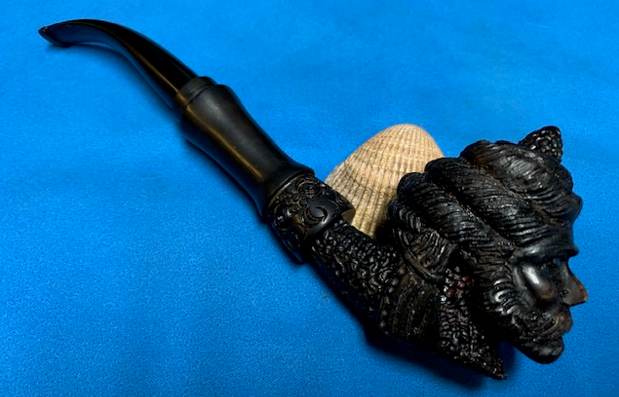Blog by Steve Laug
 Once again in this write up and I will take you through my process of working on each pipe that we purchase. Jeff has set up a spread sheet to track where the pipe came from, the date of purchase and what we paid for it so that we know what we have invested in the pipe before we even work on it. This takes a lot of the guess work out of the process. This particular pipe was purchased on 04/18/2021 from a online auction in Rimersburg, Pennsylvania, USA. I also want you to understand why we take the photos we do. If you have followed for a while then you will see the familiar pattern of the photos we include both in the before and midstream process of working on a pipe. It is not accidental or chance as the photos have been taken to help me make an assessment of the pipe Jeff sees before he starts his clean up work. We do this to record the condition that the pipe was in when received it and to assess what kind of work will need to be done on. When I look at these photos this is what I see.
Once again in this write up and I will take you through my process of working on each pipe that we purchase. Jeff has set up a spread sheet to track where the pipe came from, the date of purchase and what we paid for it so that we know what we have invested in the pipe before we even work on it. This takes a lot of the guess work out of the process. This particular pipe was purchased on 04/18/2021 from a online auction in Rimersburg, Pennsylvania, USA. I also want you to understand why we take the photos we do. If you have followed for a while then you will see the familiar pattern of the photos we include both in the before and midstream process of working on a pipe. It is not accidental or chance as the photos have been taken to help me make an assessment of the pipe Jeff sees before he starts his clean up work. We do this to record the condition that the pipe was in when received it and to assess what kind of work will need to be done on. When I look at these photos this is what I see.
- The first thing I see is the a dark (black), intricately carved figural meerschaum bowl. It is well proportioned and well made with a classic Turkish facial carved sheik.
- The finish is dirty and there is dust and debris ground into the carved finish on both side of the bowl and shank. The finish is almost a like snake/fish/dragon scales on the shank. There is a meerschaum cap on the shank extension that is carved as well and is connected to the smooth portion of the extension.
- The rim top had a light cake in the bowl and a lot of dust on the top in the carving. The bowl is undarkened in the photos looking down into the bowl. It appears to have been lightly smoked and hardly broken in.
- The bowl has a light cake in it that hides the top ½ inch of the bowl walls and the inner edge of the bowl looks quite clean and the outer edges look good and there does not appear to be any obvious damage to the top or bowl edges.
- The vulcanite taper stem is in good condition – dirty and has tooth chatter and marks on both sides ahead of the button.
Overall my impressions of this pipe is that it is a beautifully carved meerschaum that once cleaned up will look pretty amazing. The exterior of the bowl is quite dirty with dust and debris. The pipe is very Turkish looking and is a classic carved figural pipe that has the distinctive cut of other figurals pipes that I have worked on. The black stain on the finish is quite stunning and will clean up well. The photos below confirm the assessment above. 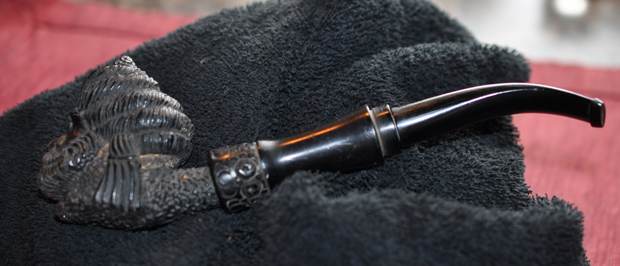 Jeff took close up photos so that I could have a clearer picture of the condition of the bowl, rim edges and top. The rim top photos confirm my assessment above. The cake in the bowl is quite thin and is only in the top ½ inch of the bowl from the top down. You can also see the condition of the edges. This is what I look for when assessing a pipe. While there is dust and grime in the finish there is no visible burn or reaming damage at this point. The bowl looks quite good.
Jeff took close up photos so that I could have a clearer picture of the condition of the bowl, rim edges and top. The rim top photos confirm my assessment above. The cake in the bowl is quite thin and is only in the top ½ inch of the bowl from the top down. You can also see the condition of the edges. This is what I look for when assessing a pipe. While there is dust and grime in the finish there is no visible burn or reaming damage at this point. The bowl looks quite good.
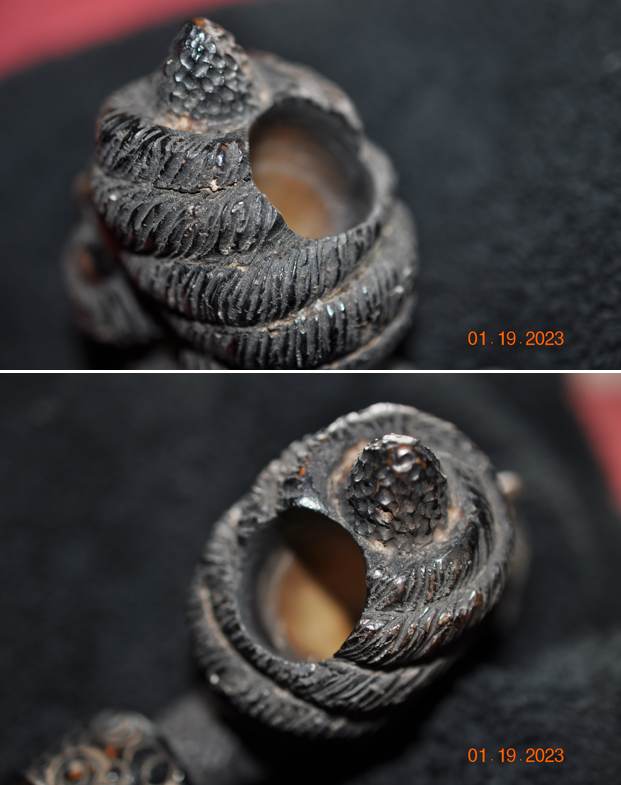 The photos of the stem surface and the shank extension from various angles confirmed my assessment of its condition. The stem surface though dirty also has light tooth marks and chatter on both sides.
The photos of the stem surface and the shank extension from various angles confirmed my assessment of its condition. The stem surface though dirty also has light tooth marks and chatter on both sides.
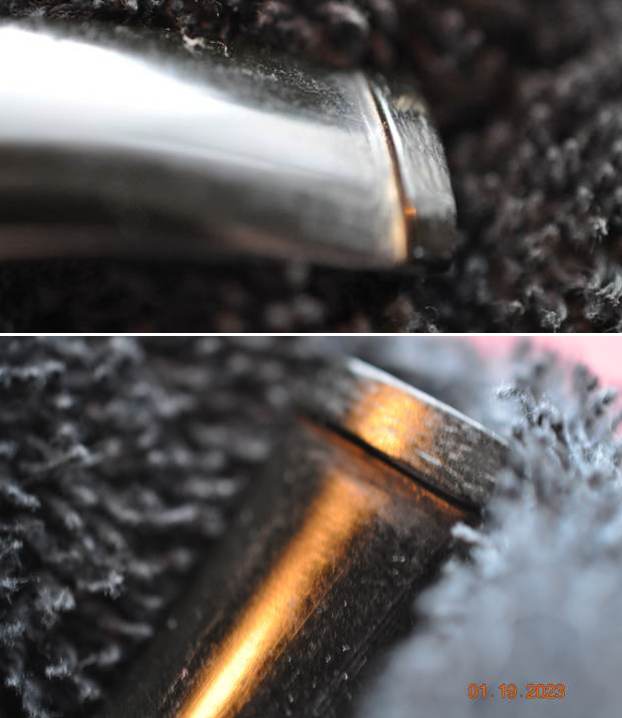 Jeff took the pipe apart to show the two different styles of tenon on this pipe. The shank extension is held to the bowl with a nylon threaded tenon that is in good condition. The tenon on the stem is a new style push tenon that pushes into a Delrin insert in the shank end.
Jeff took the pipe apart to show the two different styles of tenon on this pipe. The shank extension is held to the bowl with a nylon threaded tenon that is in good condition. The tenon on the stem is a new style push tenon that pushes into a Delrin insert in the shank end. 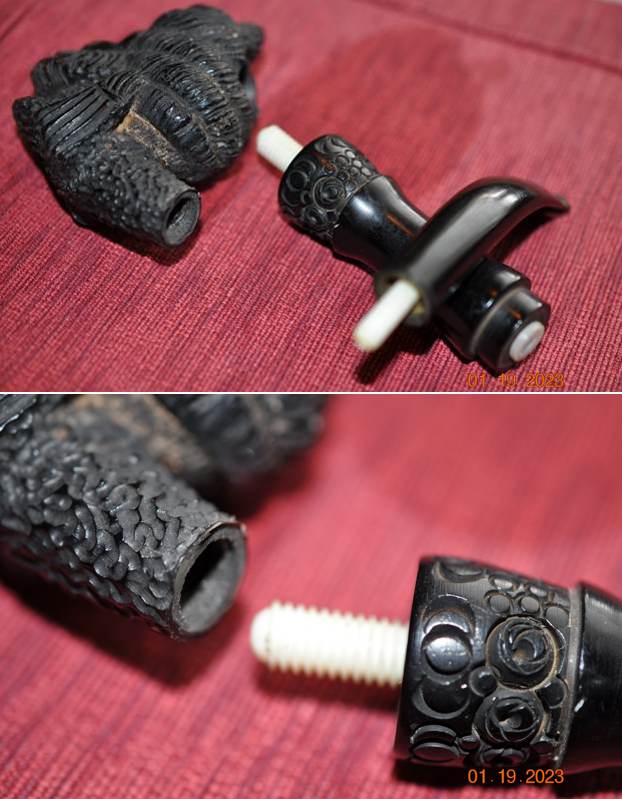
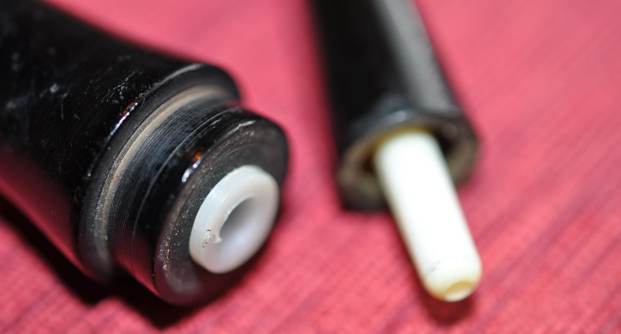 The next photos show the amazing carving strokes around the heel and the sides of the bowl. Tell me what you see? Are there any visible problems that stand out to you? Are the cracks or scratches? Are there visible flaws or chips in the meerschaum? What kind of carving and grooves are around the bowl and shank? Any visible issues on the heel of the bowl? Even the questions should help you to see what I am looking for when I see these photos.
The next photos show the amazing carving strokes around the heel and the sides of the bowl. Tell me what you see? Are there any visible problems that stand out to you? Are the cracks or scratches? Are there visible flaws or chips in the meerschaum? What kind of carving and grooves are around the bowl and shank? Any visible issues on the heel of the bowl? Even the questions should help you to see what I am looking for when I see these photos.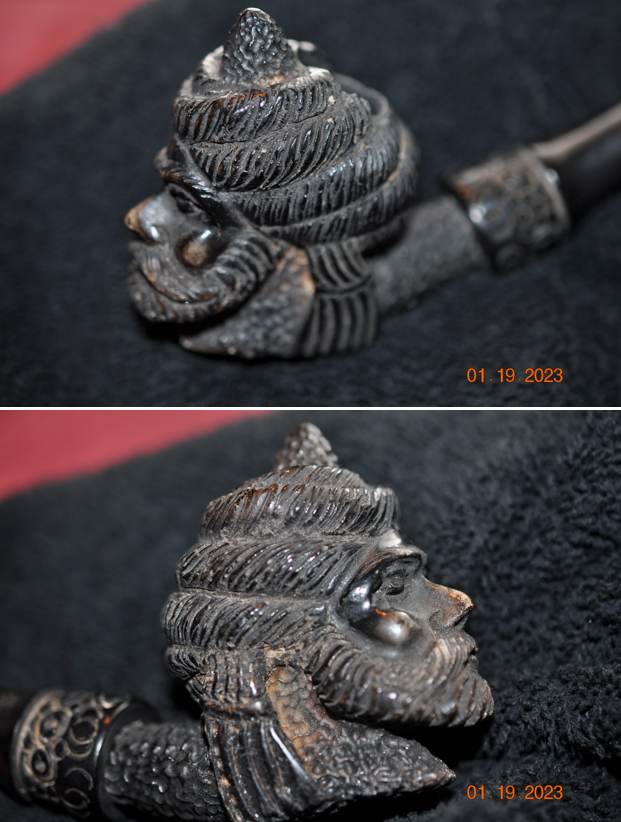
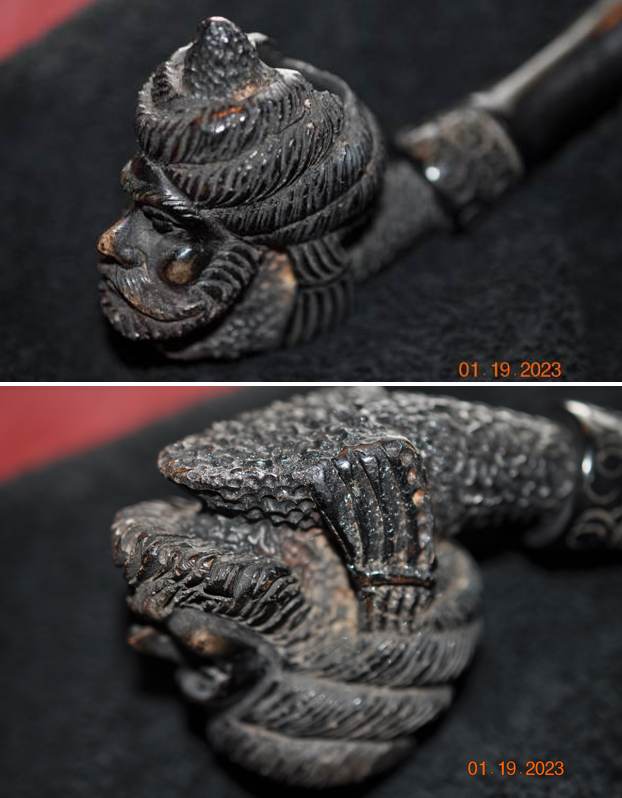 Jeff took a photo of the carved meerschaum shank extension that the longer smooth meerschaum extension was attached to. It is a uniquely carved piece of meerschaum it is carved roses and circles. It is quite beautiful. Have a look in the photo below.
Jeff took a photo of the carved meerschaum shank extension that the longer smooth meerschaum extension was attached to. It is a uniquely carved piece of meerschaum it is carved roses and circles. It is quite beautiful. Have a look in the photo below.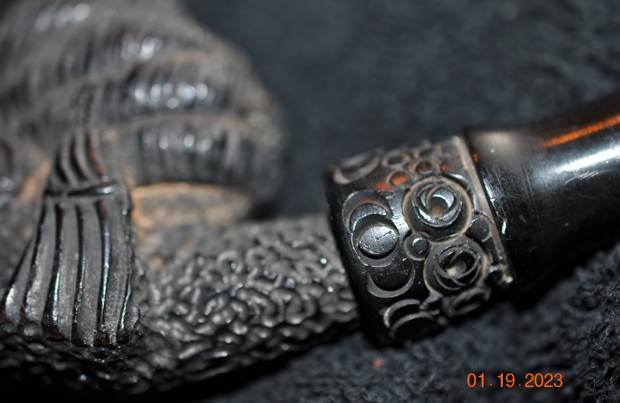 I am including Jeff’s cleaning regimen once more because in this case he used the same procedures on a meerschaum pipe. Remember that the point of these blogs is not to wow your with the work or make you shake your heads but I want you to know the details of the work we do so you can do your own. Back in 2020 Jeff wrote a blog about his cleaning process. I am including a link to that now so you can see what I mean about his process. Do not skip it! Give it a read (https://rebornpipes.com/2020/01/20/got-a-filthy-estate-pipe-that-you-need-to-clean/). Here is the introduction to that blog and it is very true even to this day.
I am including Jeff’s cleaning regimen once more because in this case he used the same procedures on a meerschaum pipe. Remember that the point of these blogs is not to wow your with the work or make you shake your heads but I want you to know the details of the work we do so you can do your own. Back in 2020 Jeff wrote a blog about his cleaning process. I am including a link to that now so you can see what I mean about his process. Do not skip it! Give it a read (https://rebornpipes.com/2020/01/20/got-a-filthy-estate-pipe-that-you-need-to-clean/). Here is the introduction to that blog and it is very true even to this day.
Several have asked about Jeff’s cleaning regimen as I generally summarize it in the blogs that I post rather than give a detailed procedure. I have had the question asked enough that I asked Jeff to put together this blog so that you can get a clear picture of the process he uses. Like everything else in our hobby, people have different methods they swear by. Some may question the method and that is fine. But it works very well for us and has for many years. Some of his steps may surprise you but I know that when I get the pipes from him for my part of the restoration they are impeccably clean and sanitized. I have come to appreciate the thoroughness of the process he has developed because I really like working on clean pipe!
For the benefit of some of you who may be unfamiliar with some of the products he uses I have included photos of three of the items that Jeff mentions in his list. This will make it easier for recognition. These three are definitely North American Products so you will need to find suitable replacements or order these directly on Amazon. The makeup pads are fairly universal as we were able to pick some up in India when we were with Paresh and his family.
In the blog itself he breaks his process down into two parts – cleaning the stem and cleaning the bowl. Each one has a large number of steps that he methodically does every time. I know because I have watched him do the work and I have seen the pipes after his work on them. He followed this process step by step and when the pipe got to me it was spotlessly clean and ready for my work. The inside of the stem, shank and bowl were clean and to me that is an amazing gift as it means that my work on this end is with a clean pipe! I cannot tell you how much difference that makes for my work.
- The first thing I see is the a dark (black), intricately carved figural meerschaum bowl. It is well proportioned and well made with a classic Turkish facial carved sheik.
- The finish is clean and the dust and debris has been removed from both sides of the bowl. The grime ground into the finish is gone and there is some great features to the carving around the bowl sides. The carved features and the scales around the bowl sides and shank look very good.
- The dust and debris on the rim top has been removed and it looks very good. The walls of the bowl are clean and I do not see any checking or burn damage. The inner and outer edge of the bowl look good.
- The vulcanite taper stem is clean and has tooth chatter and marks on both sides. There is no identifying stamping on the stem or the shank.
Hopefully the steps above show you both what I look for when I go over the pipe when I bring it to the work table and also what I see when I look at the pipe in my hands. They also clearly spell out a restoration plan in short form. My work is clear and addressing it will be the next steps. I took photos of the whole pipe to give you a picture of what I see when I have it on the table. This is important to me in that it also shows that there was no damage done during the clean up work or the transit of the pipe from Idaho to here in Vancouver. 
 I carefully went over the bowl and rim top to get a sense of what is happening there. In this case once the dust and debris was removed, the edges and top looked very good. It is clean looks very good. I also go over the stem carefully. There were no tooth marks or dents in the stem. I took photos of the rim top and stem sides to show as best as I can what I see when I look at them.
I carefully went over the bowl and rim top to get a sense of what is happening there. In this case once the dust and debris was removed, the edges and top looked very good. It is clean looks very good. I also go over the stem carefully. There were no tooth marks or dents in the stem. I took photos of the rim top and stem sides to show as best as I can what I see when I look at them.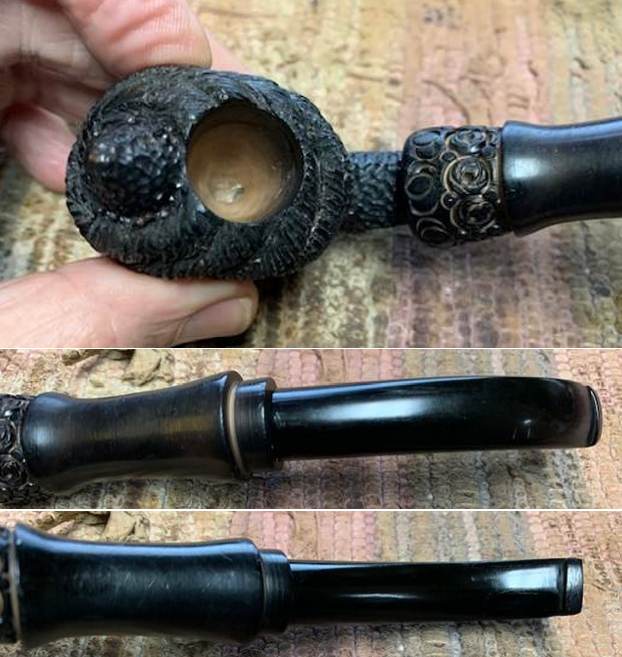 I love just looking at the beauty of the lay of the pipe with the carving and the proportion of the pipe. I like to remove the stem and the meerschaum shank extension from the shank to get a sense of what was in the mind of the pipe maker when he crafted the pipe. It is a beauty in flow and shape.
I love just looking at the beauty of the lay of the pipe with the carving and the proportion of the pipe. I like to remove the stem and the meerschaum shank extension from the shank to get a sense of what was in the mind of the pipe maker when he crafted the pipe. It is a beauty in flow and shape.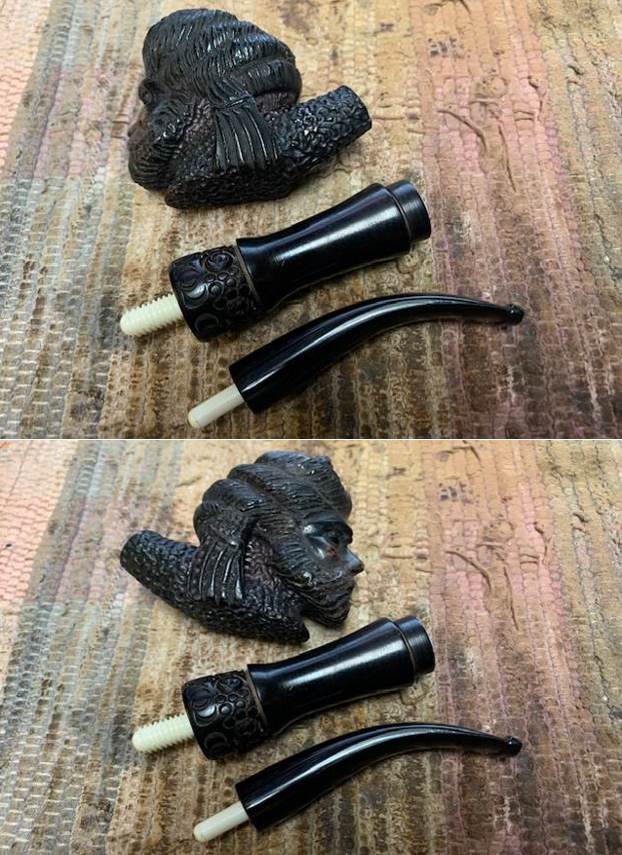
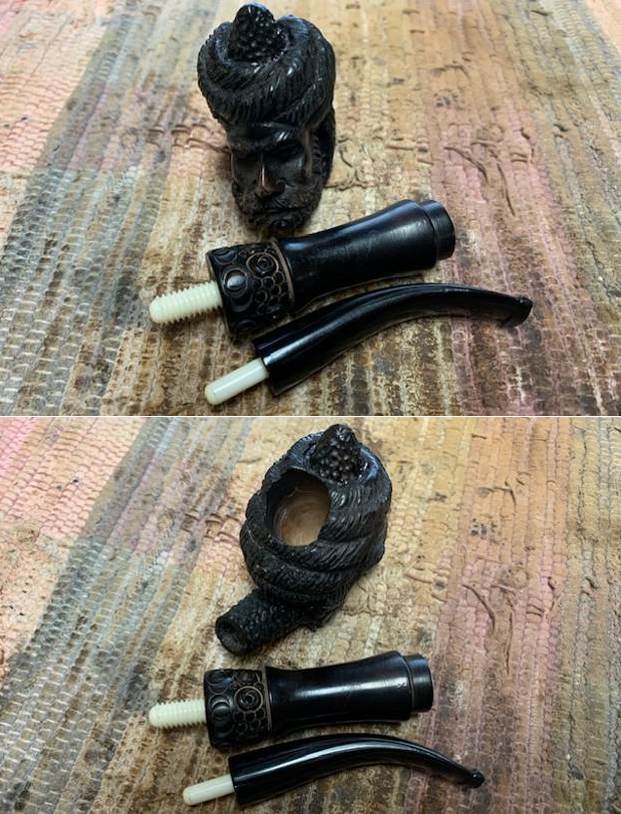 By this time you should know that I almost always start with the bowl in my restoration because I truly do not like the tedious work of stem repairs and polishing. I always leave that until last even though I know that it needs to be done. For me the encouragement of seeing a rejuvenated bowl is the impetus I need to attack the stem work.
By this time you should know that I almost always start with the bowl in my restoration because I truly do not like the tedious work of stem repairs and polishing. I always leave that until last even though I know that it needs to be done. For me the encouragement of seeing a rejuvenated bowl is the impetus I need to attack the stem work.
Today I started working on this pipe by turning to the bowl. For the past few years now I have been using Before & After Restoration Balm. It is a paste/balm that is rubbed into the surface of the briar. The product works to deep clean the nooks and crannies of finish, enliven and protect the briar. I worked it into the briar with my finger tips and let it sit for 10 minutes to do its work. I wiped it off with a soft cloth then buffed it with a cotton cloth. The briar really began to have a deep shine in the briar and the grain shone through. The photos I took of the bowl at this point mark the progress in the restoration. It is a gorgeous pipe.


 I worked the Before & After Balm into the meerschaum shank extension both the carved and smooth portions. I let the Balm sit on the surface and after 10-15 minutes buffed it off. I used a black stain pen to fill in the places at the sharp edges that had become lighter during the clean up work on it.
I worked the Before & After Balm into the meerschaum shank extension both the carved and smooth portions. I let the Balm sit on the surface and after 10-15 minutes buffed it off. I used a black stain pen to fill in the places at the sharp edges that had become lighter during the clean up work on it.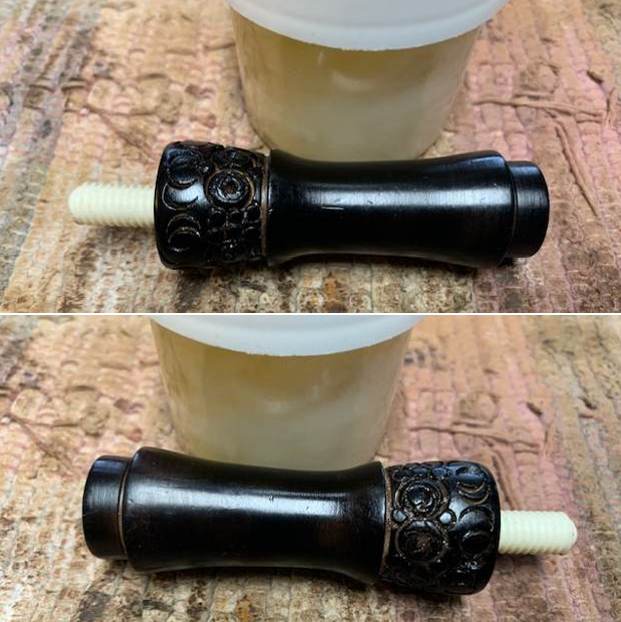
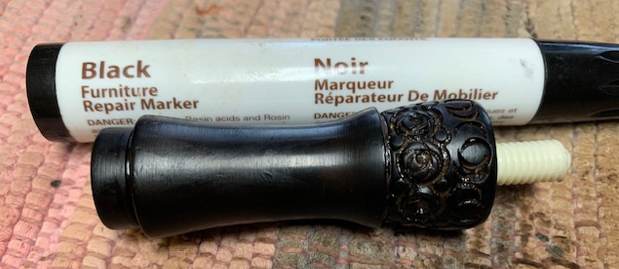 I put the shank extension back on the shank of the bowl. It is held together with a threaded nylon tenon that screws into both the shank and the extension and allows the two to be held together snug. It is a great looking pipe.
I put the shank extension back on the shank of the bowl. It is held together with a threaded nylon tenon that screws into both the shank and the extension and allows the two to be held together snug. It is a great looking pipe.
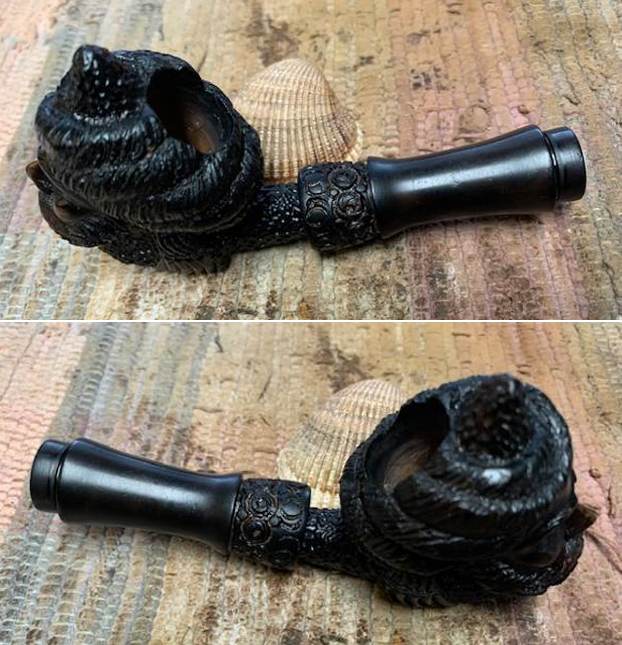
 Now it was time to address the part of the restoration I leave until last. I set the bowl aside and turned my attention to the stem. I started with the tooth marks. I sanded the stem with 220 grit sandpaper to remove the tooth marks and chatter in the vulcanite. I started the polishing of the stem with 600 grit wet dry sandpaper.
Now it was time to address the part of the restoration I leave until last. I set the bowl aside and turned my attention to the stem. I started with the tooth marks. I sanded the stem with 220 grit sandpaper to remove the tooth marks and chatter in the vulcanite. I started the polishing of the stem with 600 grit wet dry sandpaper. I use micromesh sanding pads and water to wet sand the stem with 1500-12000 grit sanding pads. I wiped it down after each sanding pad with Obsidian Oil on a cotton rag after each sanding pad as I find it does two things – first it protects the vulcanite and second it gives the sanding pads bite in the polishing process.
I use micromesh sanding pads and water to wet sand the stem with 1500-12000 grit sanding pads. I wiped it down after each sanding pad with Obsidian Oil on a cotton rag after each sanding pad as I find it does two things – first it protects the vulcanite and second it gives the sanding pads bite in the polishing process.
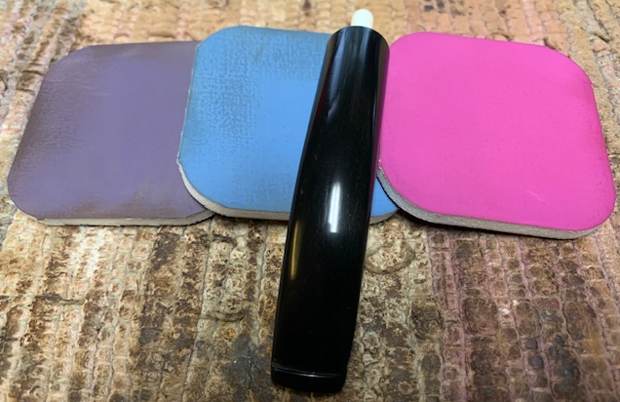 After finishing with the micromesh pads I rub the stem down with Before & After Fine and Extra Fine stem polish as it seems to really remove the fine scratches in the vulcanite. I rub the Fine Polish on the stem and wipe it off with a paper towel and then repeat the process with the extra fine polish. I finish the polishing of the stem down with a final coat of Obsidian Oil and set the stem aside to let the oil absorb. This process gives the stem a shine and also a bit of protection from oxidizing quickly.
After finishing with the micromesh pads I rub the stem down with Before & After Fine and Extra Fine stem polish as it seems to really remove the fine scratches in the vulcanite. I rub the Fine Polish on the stem and wipe it off with a paper towel and then repeat the process with the extra fine polish. I finish the polishing of the stem down with a final coat of Obsidian Oil and set the stem aside to let the oil absorb. This process gives the stem a shine and also a bit of protection from oxidizing quickly.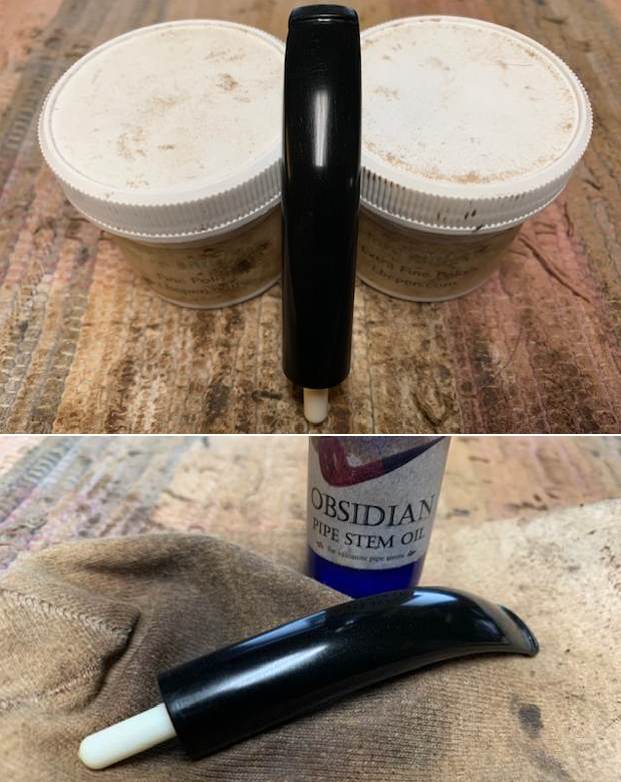 On meerschaum pipes I avoid the buffer (especially on figurals with ornate carving) as I do not want to risk flattening the carving or damaging it. I tend to do all the polishing work by hand. I gave the bowl and the stem multiple coats of rich mixture of Beeswax and Carnauba wax that is soft and can be put on by hand. I have found that I can get a deeper shine if I buff with a clean buffing pad. It works to raise the shine and then I follow that up with a hand buff with a microfiber cloth to deepen the shine. It is always fun for me to see what the polished bowl looks like with the polished vulcanite stem. It really is a beautiful pipe. The many sided carving of shapes around the bowl sides and shank show the rich craftsmanship. The rich dark stain of this Figural Carved Sheik with Beard and Turban makes the carving stand out. The finished pipe feels great in my hand. It is light and well balanced. Have a look at it with the photos below. The dimensions are Length: 8 inches, Height: 2 ¾ inches, Outside diameter of the bowl: 1 ½ inches x 2 inches, Chamber diameter: ¾ of an inch. The weight of the pipe is 2.05 ounces/57 grams. It is a beautiful pipe and one that I will be putting on the rebornpipes store in the Ceramic & Meerschaum Pipes section.
On meerschaum pipes I avoid the buffer (especially on figurals with ornate carving) as I do not want to risk flattening the carving or damaging it. I tend to do all the polishing work by hand. I gave the bowl and the stem multiple coats of rich mixture of Beeswax and Carnauba wax that is soft and can be put on by hand. I have found that I can get a deeper shine if I buff with a clean buffing pad. It works to raise the shine and then I follow that up with a hand buff with a microfiber cloth to deepen the shine. It is always fun for me to see what the polished bowl looks like with the polished vulcanite stem. It really is a beautiful pipe. The many sided carving of shapes around the bowl sides and shank show the rich craftsmanship. The rich dark stain of this Figural Carved Sheik with Beard and Turban makes the carving stand out. The finished pipe feels great in my hand. It is light and well balanced. Have a look at it with the photos below. The dimensions are Length: 8 inches, Height: 2 ¾ inches, Outside diameter of the bowl: 1 ½ inches x 2 inches, Chamber diameter: ¾ of an inch. The weight of the pipe is 2.05 ounces/57 grams. It is a beautiful pipe and one that I will be putting on the rebornpipes store in the Ceramic & Meerschaum Pipes section.
Hopefully the shape the writing of this blog is helpful to you in some way. In it I wanted to show both what I am looking for and how I move forward in addressing what I see when work on a pipe. Let me know if it is helpful to you. It is probably the most straightforward detailed description of my work process that I have done. As always I encourage your questions and comments as you read the blog. Thanks to each of you who are reading this blog. Remember we are not pipe owners; we are pipemen and women who hold our pipes in trust until they pass on into the trust of those who follow us.